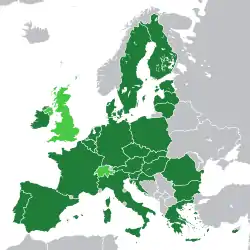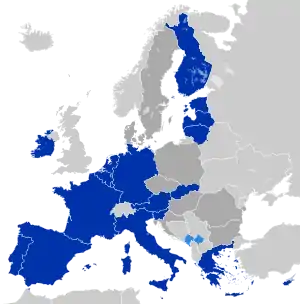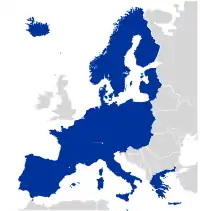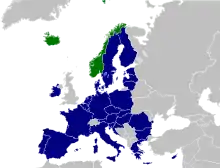European Citizens' Initiative
The European Citizens' Initiative (ECI) is a European Union mechanism aimed at increasing direct democracy by enabling "EU citizens to participate directly in the development of EU policies",[1] introduced with the Treaty of Lisbon in 2007. The initiative enables one million citizens of the European Union,[2] who are nationals of at least one quarter of the member states, to call directly on the European Commission to propose a legal act (for example a Directive or Regulation) in an area where the Member States have conferred powers onto the EU level. This right to request the Commission to initiate a legislative proposal puts citizens on the same footing as the European Parliament and the European Council, who enjoy this right according to Articles 225 and 241 TFEU, respectively. The Commission holds the right of initiative in the EU. The first ECI, Fraternité 2020, was initiated on 9 May 2012 (Europe Day).
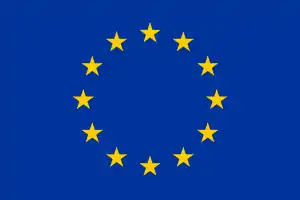 |
|---|
| This article is part of a series on the politics and government of the European Union |
|
|
Historical background
The ECI has its origins in the Constitutional Convention on the Future of Europe in 2002-2003. Thanks to the campaign work of activists and Convention members the ECI was introduced in a last-minute act into the Constitutional Treaty.[3][4]
In 2005, the Constitutional Treaty was rejected by the citizens of France and the Netherlands in two national referendums. As a consequence of that, Intergovernmental Conference prepared the Treaty of Lisbon. The treaty ratification was delayed due to referendum in Ireland where it was initially rejected in June 2008 by the Irish electorate, a decision which was reversed in a second referendum in October 2009.
On 13 December 2007, the Treaty of Lisbon was signed by all the EU Member States. On 11 November 2009, the European Commission published a Green Paper on the European Citizens’ Initiative, launching a public consultation process on the ECI.[5]
The Council and the Commission came up with a preliminary compromise on 14 June 2010. After it produced several drafts and opinions that were discussed in the Constitutional Affairs and Petitions Committees, the European Parliament, on 15 December 2010, finally voted on the ECI Regulation. After one year of negotiations, all three main EU institutions (the European Commission, the Council and the European Parliament) agreed on a final ECI Regulation, on 16 February 2011.
The initiative was inspired by Switzerland, which is not a member of the EU. The country has several tools of direct democracy such as the federal popular initiative (since 1848) and the optional referendum (since 1874).
Legal basis
The legal basis of the citizens' initiative is set out in Article 11, Paragraph 4 of the Treaty on European Union (TEU) and Article 24, paragraph 1 of the Treaty on the Functioning of the European Union (TFEU). Both articles were newly introduced with the Treaty of Lisbon. The ECI complements the existing right of petitioning the European Parliament and the right of appeal to the Ombudsman as set out in the Treaty of Maastricht (1993). Petitions and the ECI are fundamentally different however in terms of function, addressees and conditions.[6]
The practical arrangements, conditions and procedure of the ECI have been determined in the Regulation 211/2011 on the citizens' initiative, which has been applicable since 1 April 2012.[7] Commission Implementing Regulation (EU) No 1179/2011 lays down technical specifications for the ECI's online collection systems.[8]
The regulation requires a review by 1 April 2015, and every three years thereafter. In the review process, the Commission presents a report on the implementation of the ECI regulation with a view to its possible revision, to which the European Parliament reacts in a report with further recommendations.
Initiatives
Before entry into force
Greenpeace collected one million signatures in December 2010 for a petition, hosted by Avaaz, against the authorisation of new GM crops in Europe.[9] Although Greenpeace has called the petition an ECI in the media, it has never been formally registered with the Commission, which would not have been possible before 1 April 2012, and so can therefore not be regarded an ECI, as introduced by the Lisbon Treaty.
First registered initiative
The European Commission chose the symbolic date of 9 May 2012 (Europe Day) to officially launch the first ECI. It turned out to be Fraternité 2020, which had been announced by Vice-President of the Commission Maroš Šefčovič via his Twitter account one day earlier.[10] Fraternité 2020 was officially registered on 9 May and boasts registration number ECI(2012)000001.[11] The initiative failed to reach the required number of signatures.
Right2Water
On the 21 March 2013, Right2Water became the first ECI to collect more than a million signatures and it reached the minimum quota of signatures in seven countries on 7 May 2013. It stopped collecting signatures on 7 September 2013, with a total of 1,857,605 signatures. The initiative was submitted to the Commission in December 2013 and the public hearing took place on 17 February 2014 at the European Parliament.[12] In March 2014, the Commission adopted the Communication in response to the Right2Water initiative.[13] On 1 July 2015 the Roadmap for the evaluation of the Drinking Water Directive was published.[14]
One of Us
On 28 February 2014, One of Us was submitted to the commission as an ECI, having gathered 1,896,852 signatures (so far the highest number of signatures per ECI). A public hearing on the initiative took place at the European Parliament on 10 April 2014.[15] On 28 May 2014 the European Commission adopted the Communication on the European Citizens' Initiative "One of us".[16]
Stop Vivisection
On 3 March 2015, the third European Citizens' Initiative to gather the required number of signatories, Stop Vivisection, was submitted to the Commission. The campaign collected 1,326,807 signatures. On 11 May 2015, a public hearing at the European Parliament took place.[17] On 3 June 2015, the European Commission adopted the Communication on the European Citizens' Initiative "Stop Vivisection".[18]
Ban glyphosate and protect people and the environment from toxic pesticides
The initiative was submitted to the Commission on 6 October 2017. By that date, 1,070,865 signatures from 22 Member States had been checked and validated. The Commission adopted a Communication on 12 December 2017, setting out the actions it intends to take in response to the initiative.[19]
Minority Safepack
A package of 9 proposals (initially 11, 2 blocked by the Commission) aiming "to improve the protection of persons belonging to national and linguistic minorities and strengthen cultural and linguistic diversity", and submitted to the Commission on January 10, 2020. Supported by FUEN.[20]
End the Cage Age
Almost 1.4 million signatures have been gathered, as certified in October 2020.[21]
Active ECIs
More initiatives have later been registered by the Commission and include, among others, the following initiatives active as of January 2021:[22]
- Cohesion policy for the equality of the regions and sustainability of the regional cultures
- Voters Without Borders - Full political rights for EU citizens
- Save bees and farmers!
- Action on Climate Emergency
- Start Unconditional Basic Incomes (UBI) throughout the EU
- Stop corruption in Europe
- End the era of plastic in Europe
- Grow scientific progress: crops matter!
- A price for carbon to fight climate change
- Save the bees!
- Ending the aviation fuel tax exemption in Europe
- PRO-NUTRISCORE
- Cohesion policy for the equality of the regions and sustainability of the regional cultures
- The fast, fair and effective solution to climate change.
- Respect for the rule of law within the European Union
- NewRightsNow - Strengthening the rights of ‘uberised’ workers
- Housing for All
- Europe CARES - Inclusive Quality Education for Children with Disabilities
- Let's demand smarter vaping regulation!
- Reclaim Your Face[23] - Initiative for a ban on biometric mass surveillance practices
Rejected ECIs
While the first few ECIs have been approved, a few have been rejected. Among these are:[24]
- A European Citizens Initiative campaigning to phase out nuclear energy in the EU - My voice against nuclear energy;[25][26]
- A European Citizens Initiative to recommend singing the European Anthem in Esperanto;[27]
- A European Citizens Initiative to stop TTIP.[28] The alliance of organisations behind the petition have submitted a complaint in the European Court of Justice against this decision of the European Commission.[29][30] On 10 May 2017, the European Court of Justice ruled the petition legitimate.[31] The European Commission approved the initiative's registration on 4 July 2017 and reopened the signature collection on 10 July 2017.[32]
Withdrawn ECIs
A number of ECI's have decided to withdraw after being approved. Among them for example:
Procedure
| Member State | Signatories |
|---|---|
| Austria (A) | 13,500 |
| Belgium (B) | 17,750 |
| Bulgaria (BG) | 12,750 |
| Croatia (HR) | 8,250 |
| Cyprus (CY) | 4,500 |
| Czech Republic (CZ) | 15,750 |
| Denmark (DK) | 9,750 |
| Estonia (EST) | 4,500 |
| Finland (FIN) | 9,750 |
| France (F) | 55,500 |
| Germany (D) | 72,000 |
| Greece (GR) | 15,750 |
| Hungary (H) | 15,750 |
| Ireland (IRL) | 8,250 |
| Italy (I) | 54,750 |
| Latvia (LV) | 6,000 |
| Lithuania (LT) | 8,250 |
| Luxembourg (L) | 4,500 |
| Malta (M) | 4,500 |
| Netherlands (NL) | 19,500 |
| Poland (PL) | 38,250 |
| Portugal (P) | 15,750 |
| Romania (RO) | 24,000 |
| Slovakia (SK) | 9,750 |
| Slovenia (SLO) | 6,000 |
| Spain (E) | 40,500 |
| Sweden (S) | 15,000 |
| United Kingdom (GB) | 54,750 |
There are a few steps absolutely necessary to organise an ECI:[35][36]
- Step 1: Prepare the initiative and set up a citizens' committee: the members of this committee (at least 7 EU citizens, who must live in at least 7 different EU countries, old enough to vote in European Parliament elections) designate from among them a representative and a substitute to speak and act on its behalf vis-à-vis the Commission;[37]
- Step 2: Registration of the ECI in one of the 23 official EU languages on the Commission's website (answer of the commission within two months);[38]
- Step 3: For the use of an online signature collection get your system certified (by national authorities, answer within 1 months);[39][40]
- Step 4: Collection of statements of support (max. 12 months): you need to have a minimum number of signatories in at least seven EU countries on the way to 1 million (see the thresholds for each country in the table below).[41]
- Step 5: Get statements of support in each EU country certified by the national authority (answer within 3 months);[42][43]
- Step 6: Submit the ECI to the Commission.[44]
For tips on how to organise a successful ECI campaign go here. Check out also practitioner's checklist.
Weaknesses
Problems in the design of the ECI have heavily burdened ECI campaigners in the process. These include legal constraints (such as liability issues over data protection and insufficient advice regarding the appropriate legal basis of ECIs), technical issues (the online collection system is not user-friendly and does not let campaigners access email addresses of signatories to keep them informed), and bureaucratic hurdles (each member state has different data requirements and signature forms). Very few citizens are aware that the ECI exists. Moreover, there is little guarantee that a successful ECI will have an actual impact on EU legislation, as the three first ‘successful’ ECIs have shown.
The review process will offer a reflection over the successes and failures of the ECI during its first three years. Many civil society organisations, ECI organisers and Members of the European Parliament are advocating for a major reform of the ECI regulation.[45][46]
The ECI Campaign, an organization exclusively working for the successful introduction and implementation of the European Citizens’ Initiative right, has proposed 12 concrete ways to make the ECI work. Those suggestions were the result of the publication entitled "An ECI That Works. Learning from the first two years of the European Citizens' Initiative".[47]
In order to support and help ECI organizers The ECI Campaign offers a new and improved software to collect signatures called OpenECI.
The ECI Support Centre, a joint initiative of Democracy International, the European Citizen Action Service and the Initiative and Referendum Institute Europe, has developed an ‘App’ for Android smartphones, which informs users of the latest European Citizens’ Initiatives. The Centre recommends the EU Commission to develop an ECI-App, which should enable mobile signing and can help raise public awareness of the ECI.[48]
The on-line signature collection system
The ECI process allows organizers to also collect statements of support on-line. The first versions of the software provided by the European Commission have been heavily criticized by some developers.[49][50] Some organisers have also criticized the security regulations regarding the ECI collection process and the number of technical errors during the collection period.[51] In 2016, a new, fully bottom up online collection software has been provided by The ECI Campaign.[52]
Reform process 2015-2016
According to the ECI Regulation 211/2011 every three years the Commission shall present a report to the European Parliament and the Council on the application of the Regulation. In mid 2014, the European Parliament presented a new ECI study entitled "European Citizens‘ Initiative – First lessons of implementation". The analysis was conducted at the request of the AFCO and PETI Committees, and tried to identify difficulties faced by organisers when setting up and running an ECI.[53]
In October 2014 Mr. Frans Timmermans became the newly elected Commissioner responsible for the ECI. During the question and answer session in the European Parliament he avoided giving any concrete answers regarding the use or reform of the ECI.[54] A few weeks later The ECI Campaign organised a workshop "An ECI For the Next Generation". Many participants felt that the ECI was "at a crossroad" and needed reform.[55]
In December 2014 the European Citizen Action Service (ECAS) and the European Economic and Social Committee (EESC) organised a conference entitled "ECI Legal Framework – Need for Reform?". During the conference the findings and recommendations of a study undertaken by ECAS and the law firm Freshfields Bruckhaus Deringer on the legal basis of the refused ECIs were presented and discussed.[56] The overall conclusions of the study are that the legal admissibility requirements are applied in a too narrow fashion by the Commission, that decisions to refuse registration were arbitrary and that reasons given for rejection were often incomplete.
On 26 February 2015, the Constitutional Affairs (AFCO) and Petitions (PETI) committees of the European Parliament organised a public hearing on the European Citizens’ Initiative (ECI). This marked the official start of debate on the review of the ECI regulation. Despite security restrictions limiting attendance, the hearing attracted a standing-room only crowd. Present were key ECI stakeholders: the European Commission, Parliament and Council, EESC, civil society organisations and ECI organisers. Three and a half hours of discussion led the participants to the conclusion that the ECI needed reform.[57] Speaking at the hearing, Frans Timmermans, First Vice-President of the European Commission, stated that the ECI has not worked well enough and took personal responsibility to improve it so that it would not disappear.[58]
In March 2015 the European Ombudsman, Emily O'Reilly, made proposals to strengthen the role that ECI play in democratic political debate at the European level. The Ombudsman called for better guidance for ECI organisers, a stronger involvement of the European Parliament and the Council and increased pressure on the Member States to make sure that all EU citizens can sign an ECI, regardless of where they reside. Emily O'Reilly explained in her statement: "The Commission has done a lot to give effect to the ECI right in a citizen-friendly way. However, more can be done to ensure that ECI organisers feel that their efforts to mobilise one million signatures are worthwhile and that political debate at the European level takes account of their initiatives, even if specific initiatives do not lead to new EU legislation. We need a more effective dialogue with ECI organisers at different stages of an initiative as well as more transparent decision-making as regards what action the Commission takes on ECIs."[59] The Ombudsman's full list of suggestions is available online.[60]
On 31 March 2015, the Commission adopted the Report on the application of Regulation (EU) No 211/2011 on the citizens' initiative, which constitutes an important element of potential ECI reform.[61]
On 13 April 2015, third edition of the "ECI Day" took place in the European Economic and Social Committee. The conference was entitled "Review, Renew, Reset!" and focused on the EC's and Ombudsman's reports.[62] During the event The ECI Campaign presented an open letter to European Commission First Vice President Frans Timmermans, signed by 21 ECI campaigns. It called on the Commission to propose a deep and meaningful amendment to the ECI's Regulation 211/2011.[63]
In consequence of the above-mentioned conferences and reports Members of European Parliament (MEPs) on the Constitutional Affairs (AFCO) and Petitions (PETI) committees started to draft a report calling for a motion of the European Parliament on the European Citizens’ Initiative (ECI). It asks the Commission to consider several ways to make the ECI both more impactful and easier to use. AFCO Rapporteur MEP György Schöpflin presented the draft ECI report for discussion in the 16 April 2015 AFCO committee meeting. During a lively 45 minute debate, many MEPs expressed their commitment to reform and strengthen the ECI. In consequence, after 2 months of in-depth analysis over 20 members of the AFCO committee came up with 127 amendments to the draft report. Additionally, PETI and JURI committees presented their own opinions on the ECI.[64][65]
On 16 June 2015, the Latvian Presidency of the Council of the EU, the Council General Secretariat and The ECI Campaign brought together stakeholders from EU institutions, member states and civil society to reflect on the future of the ECI. This was the first ECI conference hosted in the premises of the EU Council. Stakeholders expressed deep concern that ECI use declined dramatically since 2013 and that no ECI led to a legislative proposal. All agreed that the ECI is unnecessarily complex. Participants noted that significant changes to ECI procedures are urgently needed if citizen confidence in the ECI is to be restored and it is to fulfil its promise of participatory democracy.[66]
Differences from referendums
Citizen initiatives are democratic mechanisms that let citizens propose and vote on laws and policies. By gathering a certain number of signatures, citizens can demand a binding vote on a proposed policy or legislation. With the European Citizens’ Initiative, citizens can invite the Commission to look at the proposed policy or legislation; it is not obliged to act. Citizen initiatives differ from referendums in which citizens only can accept or reject a law or policy proposed by parliament. Also, it has been stated by the European Commission that an ECI can only be the subject of the acceptation/creation of a law, but it cannot ask to reject a law.[67]
See also
References
- "Homepage – European Citizens' Initiative – European Commission". European Commission. 20 December 2013. Archived from the original on 12 January 2014. Retrieved 13 November 2020.
- "Home – European citizens' initiative – portal". European Commission. 13 November 2020. Archived from the original on 1 November 2020. Retrieved 13 November 2020.
- Michael Efler: How the Convention got convinced, 27 June 2003, citizens-initiative.eu
- Michael Efler: A rollercoaster ride toward the ECI, 27 June 2003, democracy-international.org
- "GREEN PAPER on a European Citizens' Initiative" (PDF). Eur-lex.europa.eu. Retrieved 30 January 2018.
- "Introduction". europarl.europa.eu. Archived from the original on 14 August 2015. Retrieved 25 August 2015.
- "Regulation (EU) No. 211/2011 of the European Parliament and of the Council 16 February 2011 on the citizens' initiative" (PDF). Eur-lex.europa.eu. Retrieved 30 January 2018.
- "Commission Implementing Regulation (EU) No 1179/2011 laying down technical specifications for online collection systems pursuant to Regulation (EU) No 211/2011 of the European Parliament and of the Council on the citizens' initiative" (PDF). Eur-lex.europa.eu. Retrieved 30 January 2018.
- "First European Citizens' Initiative delivered to Commissioner Dalli". Greenpeace.org. Retrieved 30 January 2018.
- "Maroš Šefčovič🇪🇺 (@MarosSefcovic) - Twitter". Twitter.com.
- "Open initiatives - European Citizens' Initiative - European Commission". Ec.europa.eu. 30 July 2014. Retrieved 15 August 2014.
- "Right to water: attend the first EP hearing for a Citizens' Initiative - News - European Parliament". Europarl.europa.eu. Retrieved 30 January 2018.
- "Communication from the Commission on the European Citizens' Initiative "Water and sanitation are a human right! Water is a public good, not a commodity!"" (PDF). Ec.europa.eu. Retrieved 30 January 2018.
- "Evaluation of the Drinking Water Directive 98/83/EC" (PDF). Ec.europa.eu. Retrieved 30 January 2018.
- "European Parliament hearing on "One of Us" European Citizens' Initiative | News | European Parliament". Retrieved 30 January 2018.
- "Communication from the Commission on the European Citizens' Initiative "One of Us"" (PDF). Ec.europa.eu. Retrieved 30 January 2018.
- "European Citizens' Initiatives - Events - AGRI - Committees - European Parliament". Europarl.europa.eu. Retrieved 30 January 2018.
- "COMMUNICATION FROM THE COMMISSION on the European Citizens' Initiative "Stop Vivisection"" (PDF). Ec.europa.eu. Retrieved 30 January 2018.
- COMMUNICATION FROM THE COMMISSION on the European Citizens' Initiative "Ban glyphosate and protect people and the environment from toxic pesticides"
- Minority SafePack – one million signatures for diversity in Europe
- Initiative citoyenne européenne: une sixième initiative présentée avec succès à la Commission//Daily News 02 / 10 / 2020 European Commission
- "Open initiatives - European Citizens' Initiative - European Commission". Ec.europa.eu. 3 February 2021. Retrieved 3 February 2021.
- "Initiative detail | European citizens' initiative - portal". europa.eu. Retrieved 3 February 2021.
- "Rejected - European Citizens' Initiative - The ECI Campaign". Citizens-initiative.eu. Retrieved 30 January 2018.
- "Refused request for registration - European Citizens' Initiative - European Commission". Ec.europa.eu. 30 July 2014. Retrieved 25 August 2015.
- ""An ECI That Works! Learning from the first two years of the European Citizens' Initiative." / "My Voice against Nuclear Power"" (PDF). Ecithatworks.org. Retrieved 30 January 2018.
- "Refused request for registration - European Citizens' Initiative - European Commission". Ec.europa.eu. 30 July 2014. Retrieved 25 August 2015.
- "Question on Refused request for registration - European Citizens' Initiative - European Commission". Retrieved 12 November 2014.
- "European Citizens' Initiative against TTIP: Submission of complaint in the European Court of Justice". Stop-ttip.org. Retrieved 30 January 2018.
- [Case T-754/14: Action brought on 10 November 2014 — Efler and Others v Commission. http://eur-lex.europa.eu/legal-content/EN/TXT/?uri=uriserv:OJ.C_.2015.034.01.0039.02.ENG] Eur-lex.europa.eu
- "'Stop TTIP' petition is legitimate, top EU court rules". Euractiv.com. Retrieved 13 April 2018.
- "L'Europe donne son feu vert à une action de pétition contre le TTIP". 4 July 2017. Retrieved 13 April 2018.
- "European Commission > European Citizens' Initiative > EU Directive on Dairy Cow Welfare". Ec.europa.eu. 30 July 2014. Retrieved 25 August 2015.
- "European Commission > European Citizens' Initiative > Kündigung Personenfreizügigkeit Schweiz" [Abolish Freedom of Movement for Swiss People] (in German). Ec.europa.eu. 30 July 2014. Retrieved 25 August 2015.
- "The procedure step by step - European Citizens' Initiative - European Commission". Ec.europa.eu. Retrieved 30 January 2018.
- "Guide to the European Citizens' Initiative - European Commission". Ec.europa.eu. 30 July 2014. Retrieved 15 August 2014.
- "Citizens' committee - The procedure step by step - European Citizens' Initiative - European Commission". Ec.europa.eu. Retrieved 30 January 2018.
- "Registration - The procedure step by step - European Citizens' Initiative - European Commission". Ec.europa.eu. Retrieved 30 January 2018.
- "Competent national authorities that certify online collection systems - European Citizens' Initiative - European Commission". Ec.europa.eu. 30 July 2014. Retrieved 15 August 2014.
- "Certification of online system - The procedure step by step - European Citizens' Initiative - European Commission". Ec.europa.eu. Retrieved 30 January 2018.
- "Collection - The procedure step by step - European Citizens' Initiative - European Commission". Ec.europa.eu. Retrieved 30 January 2018.
- "Competent national authorities that certify statements of support - European Citizens' Initiative - European Commission". Ec.europa.eu. 30 July 2014. Retrieved 15 August 2014.
- "Verification of statements - The procedure step by step - European Citizens' Initiative - European Commission". Ec.europa.eu. Retrieved 30 January 2018.
- "Submission of the initiative - The procedure step by step - European Citizens' Initiative - European Commission". Ec.europa.eu. Retrieved 30 January 2018.
- "The ECI Campaign - 12 ways to build an ECI that works". Citizens-initiative.eu. Retrieved 25 August 2015.
- "Democracy International - European Citizens' Initiative Reform". Democrary-international.org. Retrieved 5 March 2015.
- "ECI That Works! - Learning from the first two years of the European Citizens' Initiative". Ecithatworks.org. Retrieved 30 January 2018.
- "ECI Support Centre - ECAS". Ecas.org. Retrieved 30 January 2018.
- ""An ECI That Works. Learning from the first two years of the European Citizens' Initiative." - Interview with Xavier Dutoit" (PDF). Ecithatworks.org. Retrieved 30 January 2018.
- ""An ECI That Works. Learning from the first two years of the European Citizens' Initiative." - Reinder Rustema - "Why the ECI needs a Community-Developed Online Collection System"" (PDF). Ecithatworks.org. Retrieved 30 January 2018.
- ""An ECI That Works. Learning from the first two years of the European Citizens' Initiative."" (PDF). Ecithatworks.org. Retrieved 30 January 2018.
- "ECI Software that Works! OpenECI is designed by and for ECI campaigners - European Citizens' Initiative - The ECI Campaign". Citizens-initiative.eu. 8 December 2015. Retrieved 30 January 2018.
- "European Parliament, "European Citizens' Initiative – First lessons of implementation"" (PDF). Europarl.europa.eu. Retrieved 30 January 2018.
- "The ECI Campaign". Citizens-initiative.eu. Retrieved 30 January 2018.
- "The ECI Campaign". Citizens-initiative.eu. Retrieved 30 January 2018.
- "ECAS - "The European Citizens' Initiative Registration: Falling at the First Hurdle? Analysis of the registration requirements and the "subject matters" of the rejected ECIs"" (PDF). Ecas.org. Retrieved 30 January 2018.
- "The ECI Campaign". Citizens-initiative.eu. Retrieved 30 January 2018.
- "The ECI Campaign". Citizens-initiative.eu. Retrieved 30 January 2018.
- "Ombudsman calls on Commission to make European Citizens' Initiative politically relevant". Ombudsman.europa.eu. Retrieved 30 January 2018.
- "Decision of the European Ombudsman closing her own-initiative inquiry OI/9/2013/TN concerning the European Commission". Ombudsman.europa.eu. Retrieved 30 January 2018.
- "Report on the application of Regulation (EU) No 211/2011 on the citizens' initiative" (PDF). Ec.europa.eu. Retrieved 30 January 2018.
- "EESC, ECI Day 2015 General Report" (PDF). Eesc.europa.eu. Retrieved 30 January 2018.
- "The ECI Campaign". Citizens-initiative.eu. Retrieved 30 January 2018.
- "Opinion of the Committee on Petitions for the Committee on Constitutional Affairs on the European Citizens' Initiative". Europarl.europa.eu. Retrieved 30 January 2018.
- "Opinion of the Committee on Legal Affairs for the Committee on Constitutional Affairs on the European Citizens' Initiative". Europarl.europa.eu. Retrieved 30 January 2018.
- "The ECI Campaign". Citizens-initiative.eu. Retrieved 30 January 2018.
- "Refusal of the Stop TTIP ICE". Ec.europa.eu. 10 September 2014. Retrieved 11 May 2015.
External links
- ec.europa.eu/citizens-initiative – European Citizens' Initiative on the European Commission's website
- European Citizens' Initiative on the initiators' websites:
- citizens-initiative.eu (also: ecicampaign.org) – European Citizens' Initiative (ECI) on the ECI Campaign web
- democracy-international.org/eci.html – European Citizens' Initiative (ECI) on the Democracy International web
- mehr-demokratie.de/eu-buergerinitiative.html – Europäische Bürgerinitiative on the Mehr Demokratie (More Democracy) web
- Further, other websites:
- clicknsign.eu – ClicknSign, "the first social platform dedicated to citizens' empowerment through the ECI"
- Websites of (some) European Citizens' Initiatives (in order of registration):
- fraternite2020.eu – Fraternité 2020
- right2water.eu – Right 2 Water
- oneofus.eu – One of Us
- endecocide.org – End Ecocide on Earth
- stop-ttip.org – Stop TTIP
- ECI/s on citizens-initiative.eu (also: ecicampaign.org) one of the ECI initiators' websites:
- European Citizens’ Initiative – in that section: What is the ECI? / Open ECIs / Closed ECIs / Rejected ECIs / An overview of the first 2 years of the European Citizens’ Initiative
- ECIs on the Commission's website:
- Closed (finalised) initiatives:
- Collection closed – collection is closed, not (yet) submitted to the Commission
- Submitted to the Commission – reached the required number of signatures, Commission's answer pending.
- Answered by the Commission – Commission's conclusions already presented
- Obsolete initiatives:
- Withdrawn – withdrawn by the organisers
- Insufficient support – did not gather the required number of signatures within the 1-year time limit
- Refused initiatives:
- Refused requests for registration – did not comply with the conditions according to Art.4(2) of the Regulation on the ECI, with the negative Commission's replies
- Closed (finalised) initiatives:

